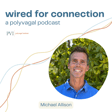
Integrating IFS & Polyvagal Theory with Dr. Frank Anderson
In this episode of Wired for Connection, host Travis Goodman interviews Dr. Frank Anderson, founder of the Trauma Institute and a renowned leader in trauma healing. Together, they explore Dr. Anderson’s journey into trauma work, his evolution in understanding healing as both an internal and relational process, and the integration of Internal Family Systems (IFS) with Polyvagal Theory. Through personal stories and professional insight, Dr. Anderson shares his perspectives on parts work, the significance of ‘self’ and ‘soul,’ and the nuanced ways trauma shapes and can heal the nervous system.
For more resources or to get involved, visit polyvagal.org alongside Dr. Anderson's website at www.frankandersonmd.com.
CONNECT WITH Polyvagal Institute:
WEB: www.polyvagalinstitute.org
Instagram: @polyvagalinstitute
LinkedIn: polyvagal-institute
Email: community@polyvagal.org
CONNECT WITH Travis Goodman:
Instagram: Travis.Goodman.LMFT





